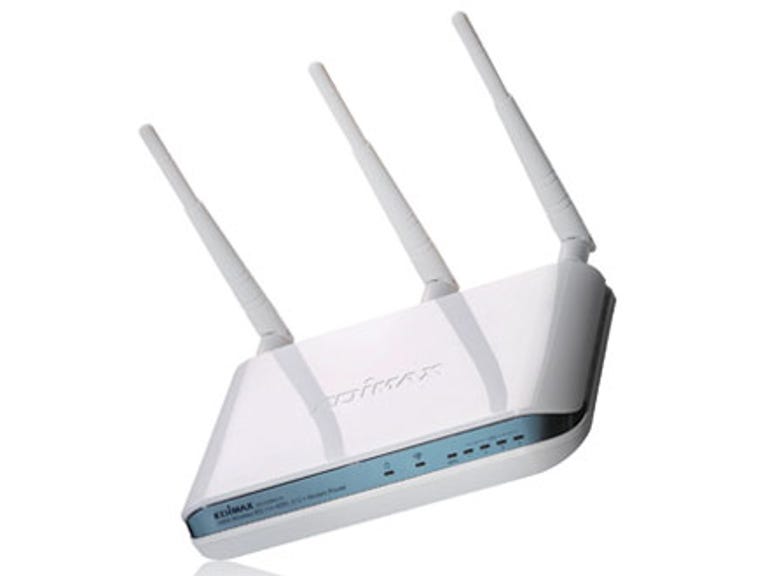 Why You Can Trust CNET
Why You Can Trust CNET Edimax nMax AR-7265Wn Wireless 802.11n ADSL2/2+ modem router review: Edimax nMax AR-7265Wn Wireless 802.11n ADSL2/2+ modem router
Edimax's 802.11n router combines a perfect storm of poor throughput and unfriendly set-up routines to make a modem/router that's incredibly easy to pass by.
Design
The Edimax nMax AR-7265Wn is a mostly white router that's pretty reminiscent of Netcomm's recent NP802n router in design terms; it's small, triple-antenna equipped and features the classic and largely indiscernible blinking lights on the front display panel. Where it differs from Netcomm's offering is in the placement of the rear antennas, which flank the four Ethernet ports, rather than splitting them, and in the number of times that the product logo appears on the box. There's a single small logo on the front panel. An embedded logo on the top of the box, and if you choose to vertically mount the nMax AR-7265Wn, you'll discover a much larger etched logo on the base of the unit. Edimax, in other words, doesn't want you or any of your visitors to forget who's supplying their networking technology.
The Good
The Bad
The Bottom Line
Our one criticism of the Edimax nMax AR-7265Wn's design would be the antennas, which once screwed in were rather loose, and had a tendency to flop down a lot, even in horizontal orientation. This could have adverse effects on overall signal strength, although it's worth noting that the AR-7265Wn uses standard antenna screws, so you could always substitute stiffer units in place.
Features
The nMax AR-7265Wn is a wireless-N capable router and ADSL2/2+ capable modem in one box, and not surprisingly, it features most of the standard fittings of devices of this class. There's the usual claim of 300Mbps throughput (more on that shortly), Wi-Fi Protected Set-up (WPS) support, DHCP, WPA support and not a whole lot else. Its 802.11n implementation is 2.4GHz only, which raises the spectre of interference in most locations — again, more on this shortly.
Installing the Edimax nMax AR-7265Wn is a process of either running the installation CD (for novices on a Windows machine) or a traditional web-based set-up (for those who prefer that, or non-Windows users). On the accessibility side, the supplied installation CD does come in a variety of languages, which is a nice touch. The one factor to keep in mind with the web install set-up is that Edimax pulls no punches in revealing networking terminology, and as such, the web interface can be confusing if you're not sure of your ISP's networking settings down to the last detail. Its VPI/VCI default settings probably won't work for most Australian ISPs, which could needlessly confuse less network-literate users. Oddly, the Edimax nMax AR-7265Wn's CD-based install includes Australia in its list of countries, but only a single ISP — and it's not one of the big players, either. We've no idea why.
Performance
In our Australian tests to date, 802.11n has been a bit of a dud. Yes, it's quicker in our test environment than most 802.11g routers, but when an entire industry hypes a technology as being capable of running nearly six times faster than 802.11g, we'd like them to deliver on those promises. Could Edimax's take on 802.11n deliver?
Signal strength: 2.4GHz
| Edimax nMax AR-7265Wn | 77% | 58% | 55% |
| NetComm NP802n | 79% | 49% | 52% |
| Linksys WRT610N | 79% | 50% | 53% |
| Netgear WNDR3300 | 85% | 44% | 45% |
| Netgear WNHDEB111 | 84% | 50% | 55% |
| Linksys WAG160N | 70% | 53% | 48% |
| Billion BiPAC 7300N | 75% | 59% | 54% |
| Conceptronic 300Mbps | 92% | 62% | 60% |
| Linksys WRT160N | 80% | 62% | 50% |
On signal strength, the AR-7265Wn performed adequately, but certainly not to a world-beating standard. Given it's operating in the 2.4GHz spectrum, that's not terribly shocking.
Throughput: 2.4GHz
| Edimax nMax AR-7265Wn | 2.95Mbs | 3.09Mbs |
| NetComm NP802n | 18.2Mbps | 16.4Mbps |
| Linksys WRT610N | 22.3Mbps | 7.91Mbps |
| Netgear WNDR3300 | 11.8Mbps | 9.81Mbps |
| Netgear WNHDEB111 | 18.4Mbps | 16.7Mbps |
| Linksys WAG160N | 19.8Mbps | 15.2Mbps |
| Billion BiPAC 7300N | 21Mbps | 13.3Mbps |
| Conceptronic 300Mbps | 15Mbps | 7.7Mbps |
| Linksys WRT160N | 4.88Mbps | 10.12Mbps |
While the AR-7265Wn performed acceptably (but not exceptionally) in our signal tests, our throughput tests (which involve a transfer of a folder of files between two wirelessly connected computers) displayed it looking exceptionally poor indeed; we've used 802.11g routers with better overall performance. Clearly, with wireless testing there's a lot of scope for environmental interference, and results in a different location may yield different results. As it stands though, compared to everything else 802.11n we've tested recently, the AR-7265Wn simply isn't worth your money.



